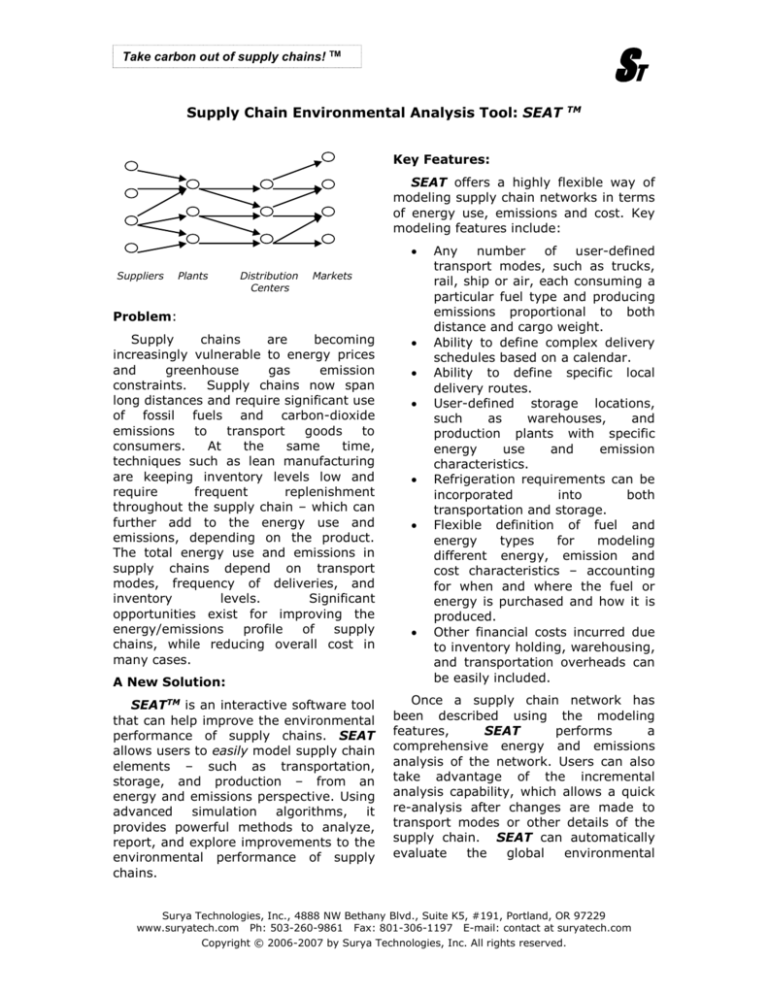
Take carbon out of supply chains!
ST
TM
Supply Chain Environmental Analysis Tool: SEAT
TM
Key Features:
SEAT offers a highly flexible way of
modeling supply chain networks in terms
of energy use, emissions and cost. Key
modeling features include:
Suppliers
Plants
Distribution
Centers
Markets
Problem:
Supply
chains
are
becoming
increasingly vulnerable to energy prices
and
greenhouse
gas
emission
constraints.
Supply chains now span
long distances and require significant use
of fossil fuels and carbon-dioxide
emissions
to
transport
goods
to
consumers.
At
the
same
time,
techniques such as lean manufacturing
are keeping inventory levels low and
require
frequent
replenishment
throughout the supply chain – which can
further add to the energy use and
emissions, depending on the product.
The total energy use and emissions in
supply chains depend on transport
modes, frequency of deliveries, and
inventory
levels.
Significant
opportunities exist for improving the
energy/emissions
profile
of
supply
chains, while reducing overall cost in
many cases.
A New Solution:
SEATTM is an interactive software tool
that can help improve the environmental
performance of supply chains. SEAT
allows users to easily model supply chain
elements – such as transportation,
storage, and production – from an
energy and emissions perspective. Using
advanced
simulation
algorithms,
it
provides powerful methods to analyze,
report, and explore improvements to the
environmental performance of supply
chains.
Any
number
of
user-defined
transport modes, such as trucks,
rail, ship or air, each consuming a
particular fuel type and producing
emissions proportional to both
distance and cargo weight.
Ability to define complex delivery
schedules based on a calendar.
Ability to define specific local
delivery routes.
User-defined storage locations,
such
as
warehouses,
and
production plants with specific
energy
use
and
emission
characteristics.
Refrigeration requirements can be
incorporated
into
both
transportation and storage.
Flexible definition of fuel and
energy
types
for
modeling
different energy, emission and
cost characteristics – accounting
for when and where the fuel or
energy is purchased and how it is
produced.
Other financial costs incurred due
to inventory holding, warehousing,
and transportation overheads can
be easily included.
Once a supply chain network has
been described using the modeling
features,
SEAT
performs
a
comprehensive energy and emissions
analysis of the network. Users can also
take advantage of the incremental
analysis capability, which allows a quick
re-analysis after changes are made to
transport modes or other details of the
supply chain. SEAT can automatically
evaluate
the
global
environmental
Surya Technologies, Inc., 4888 NW Bethany Blvd., Suite K5, #191, Portland, OR 97229
www.suryatech.com Ph: 503-260-9861 Fax: 801-306-1197 E-mail: contact at suryatech.com
Copyright © 2006-2007 by Surya Technologies, Inc. All rights reserved.
Take carbon out of supply chains!
ST
TM
impacts of local changes to the supply
chain.
The analysis can be used in several
ways:
Evaluating the total energy used
and
carbon-dioxide
emissions
produced, including the exact
locations and links in supply
chains that contribute significantly
to the environmental footprint.
Determining how overall energy
and inventory costs can be
reduced
while
also
reducing
emissions.
Comparing
the
environmental
performance and cost for alternate
supply
chain
configurations.
Variables
include:
production
batch sizes, transport modes,
distances, various combinations of
local and long-distance suppliers
and markets, etc.
SEAT’s
outputs
can
be
made
compatible with the corporate reporting
standard of the Greenhouse Gas Protocol
as an option. We can work with you to
attain compliance with other reporting
standards.
Applications:
SEAT can be used within a wide
range of applications, including:
Inputs and Outputs:
SEAT has the look and feel of a
typical Windows application. Supply
chain elements in SEAT can be described
or modified, and connected to other
elements, using a series of dialog boxes.
Alternately, an entire supply chain
network can be described using a simple
and compact modeling language in a text
file. Any changes made interactively can
be retained by saving the entire model of
the network as a text file for future use.
If your supply chain data is available
in other formats or databases, we offer
services to convert the data into the
SEAT format.
Results produced by SEAT
available in multiple formats:
are
Results can be displayed on screen
in a tabular format, and then
optionally printed or saved as a
PDF file.
Results can be saved as an XML
file, which can then be read
directly into Excel for further use.
Results can also be saved as a
text file.
Achieving overall cost savings
from reduced energy use in supply
chains.
Meeting voluntary or mandatory
greenhouse gas emission targets,
and
receiving
recognition
or
official credit for it.
Emission calculations for use in
offsetting carbon footprints.
Detailed reporting of energy use
and emissions as part of corporate
environmental reporting.
Additional Features in the Pipeline:
Future versions of SEAT will include
several additional features related to
supply
chain
environmental
performance, such as:
Analysis
of
additional
transportation emissions (nitrogen
and sulfur oxides).
Automatic optimization of energy
use and emissions.
Analysis of the environmental
impact of product packaging.
Platform Support and Availability:
SEAT runs on Microsoft Windows
platforms (Windows XP SP2, Windows
Server 2003, Windows 2000 SP3), and is
now available as part of service
agreements.
For more product information, please
visit our environmental performance web
site at www.suryatech.com/ep
Surya Technologies, Inc., 4888 NW Bethany Blvd., Suite K5, #191, Portland, OR 97229
www.suryatech.com Ph: 503-260-9861 Fax: 801-306-1197 E-mail: contact at suryatech.com
Copyright © 2006-2007 by Surya Technologies, Inc. All rights reserved.








